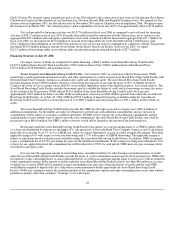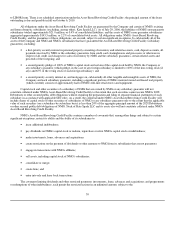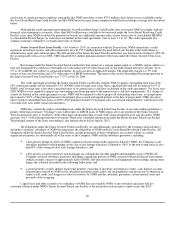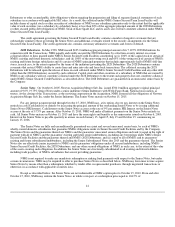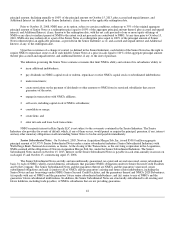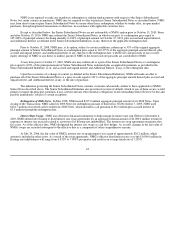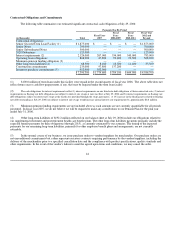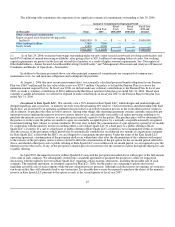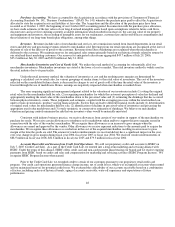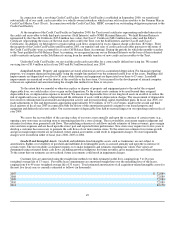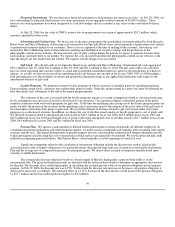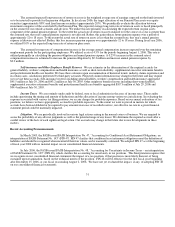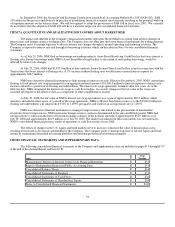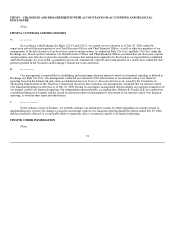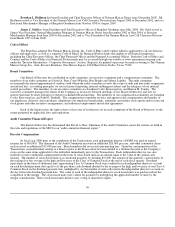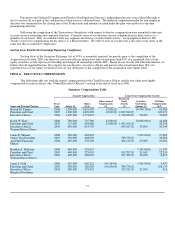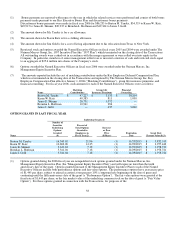Neiman Marcus 2005 Annual Report Download - page 52
Download and view the complete annual report
Please find page 52 of the 2005 Neiman Marcus annual report below. You can navigate through the pages in the report by either clicking on the pages listed below, or by using the keyword search tool below to find specific information within the annual report.
Purchase Accounting. We have accounted for the Acquisition in accordance with the provisions of Statement of Financial
Accounting Standards No. 141, "Business Combinations," (SFAS No. 141) whereby the purchase price paid to effect the Acquisition is
allocated to state the acquired assets and liabilities at fair value. The Acquisition and the allocation of the purchase price have been
recorded as of October 1, 2005, the beginning of our October 2005 accounting period. In connection with the purchase price allocation,
we have made estimates of the fair values of our long-lived and intangible assets based upon assumptions related to future cash flows,
discount rates and asset lives utilizing currently available information which resulted in increases in the carrying value of our property
and equipment and inventory, the recording of intangible assets for our tradenames, customer lists and favorable lease commitments and
the revaluation of our long-term benefit plan obligations, among other things.
Revenues. Revenues include sales of merchandise and services, net commissions earned from leased departments in our retail
stores and delivery and processing revenues related to merchandise sold. Revenues from our retail operations are recognized at the later of
the point of sale or the delivery of goods to the customer. Revenues from Direct Marketing are recognized when the merchandise is
delivered to the customer. We maintain reserves for anticipated sales returns primarily based on our historical trends related to returns by
our retail and direct marketing customers. Our reserves for anticipated sales returns aggregated $43.7 million at July 29, 2006,
$35.2 million at July 30, 2005 and $30.8 million at July 31, 2004.
Merchandise Inventories and Cost of Goods Sold. We utilize the retail method of accounting for substantially all of our
merchandise inventories. Merchandise inventories are stated at the lower of cost or market. The retail inventory method is widely used in
the retail industry due to its practicality.
Under the retail inventory method, the valuation of inventories at cost and the resulting gross margins are determined by
applying a calculated cost-to-retail ratio, for various groupings of similar items, to the retail value of inventories. The cost of the inventory
reflected on the consolidated balance sheets is decreased by charges to cost of goods sold at the time the retail value of the inventory is
lowered through the use of markdowns. Hence, earnings are negatively impacted when merchandise is marked down.
The areas requiring significant management judgment related to the valuation of our inventories include (1) setting the original
retail value for the merchandise held for sale, (2) recognizing merchandise for which the customer's perception of value has declined and
appropriately marking the retail value of the merchandise down to the perceived value and (3) estimating the shrinkage that has occurred
between physical inventory counts. These judgments and estimates, coupled with the averaging processes within the retail method can,
under certain circumstances, produce varying financial results. Factors that can lead to different financial results include (1) determination
of original retail values for merchandise held for sale, (2) identification of declines in perceived value of inventories and processing the
appropriate retail value markdowns and (3) overly optimistic or conservative estimation of shrinkage. We believe our merchandise
valuation and pricing controls minimize the risk that our inventory values would be materially misstated.
Consistent with industry business practice, we receive allowances from certain of our vendors in support of the merchandise we
purchase for resale. We receive certain allowances to reimburse us for markdowns taken and/or to support the gross margins earned in
connection with the sales of the vendor's merchandise. We recognize these allowances as an increase to gross margin when the
allowances are earned and approved by the vendor. Other allowances we receive represent reductions to the amounts paid to acquire the
merchandise. We recognize these allowances as a reduction in the cost of the acquired merchandise resulting in an increase to gross
margin at the time the goods are sold. The amount of vendor reimbursements we received did not have a significant impact on the year-
over-year change in gross margin during fiscal year 2006, fiscal year 2005 or fiscal year 2004. We received vendor reimbursements of
$88.9 million in fiscal year 2006, $82.8 million in fiscal year 2005 and $79.3 million in fiscal year 2004.
Accounts Receivable and Income from Credit Card Operations. We sold our proprietary credit card accounts to HSBC on
July 7, 2005 (Credit Card Sale). As a part of the Credit Card Sale, we entered into a long-term marketing and servicing alliance with
HSBC. Under the terms of this alliance, HSBC offers credit card and non-card payment plans bearing our brands and we receive ongoing
payments from HSBC based on credit card sales and compensation for marketing and servicing activities (HSBC Program Income). We
recognize HSBC Program Income when earned.
Prior to the Credit Card Sale, we extended credit to certain of our customers pursuant to our proprietary retail credit card
program. Our credit card operations generated finance charge income, net of credit losses, which was recognized as income when earned
and we maintained reserves for potential credit losses. We evaluated the collectibility of our accounts receivable based on a combination
of factors, including analysis of historical trends, aging of accounts receivable, write-off experience and expectations of future
performance.
48


